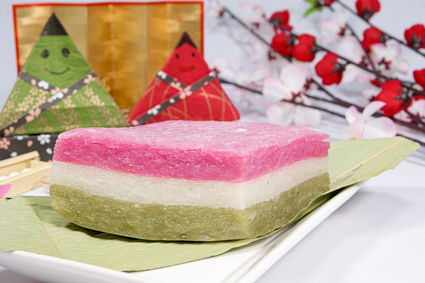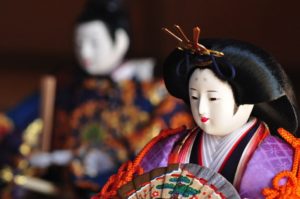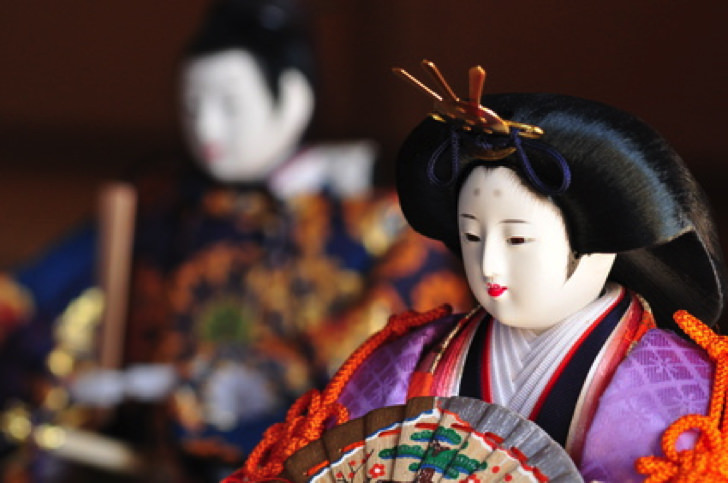日本の伝統行事のひな祭り
これを英語でどのように説明しますか?

こんんちは!シゲル(@shigemaropress)です。
日本生まれ、日本育ちで偏差値53の高校を卒業しましたが、TOEIC965、IELTSは7.0取得し、英語を使う会社で働きつつ、副業で外国人を相手にビジネスをして外貨を稼いでいます。
2月の節分を過ぎたあたりから、全国各地の各家庭でひな壇が飾られ始めますね。
女の子がいる家庭で行われるこの行事は、女の子のすこやかな成長を願って行われます。
しかしなぜ、
- ひな壇や雛人形
- 菱餅
- ハマグリのお吸い物
- ちらし寿司
といった物が用意されるのでしょうか?
ぜひ外国人に英語で説明する際に、この辺も突っ込んで説明したいですよね。
この記事では、ひな祭りの由来や上記の疑問に対する答えを紹介します。
その上で、ひな祭りを説明する英文を紹介します。
英作文のトピックとして申し分ないと思いますので、ぜひ参考にして見てください。
ひな祭りはなぜ3月3日に行われるのか?
「ひな祭り」は女の子のすこやかな成長を願って行われます。
しかしなぜ、3月3日に行われるのでしょうか?
元々は「上巳の節句」に行われていました。上巳(じょうし・じょうみ)とは3月上旬の巳の日のことですが、後になって日付が変動しないように3月3日に固定されたのです
節句とは?
節句とは季節の変わり目(節目)の事で、それぞれの行事があり、特別な食べ物を食べる風習があります。
季節の変わり目(節句)には、災いをもたらす邪気が入りやすいと思われていたため、身のけがれを祓う必要がありました。
平安時代には、子供の無病息災を願うお祓いを3月の巳の日に行なっていたのです。
旧暦の3月上旬は、新暦の4月上旬ごろにあたり、ちょうど桃の花が咲く頃です。
桃の木には邪気を祓う力があると考えられていました。
そのため「上巳の節句」は「桃の節句」とも呼ばれるようになったのです。
なぜひな祭りには雛人形を飾るのか
「ひな祭り」と「雛人形」はどのようにして繋がっているのか?
それは、2つの行事がルーツとなり合わさったものです。
- ひいな遊び
- 流し雛
ひいな遊び
現代の「おままごと」や「お人形さんごっこ」にあたる女の子のお遊びです。
平安時代の京都で、貴族の子女の遊びごととして行われていた記録があります。
流し雛
自分のケガレを人形(ひとがた)の紙に移して、それを毎年川や海に流していました。
これが、流し雛と呼ばれ、現在も京都の下神神社のものが有名です。
ひな壇に飾るまで
この2つの行事が、合わさったのは江戸時代と言われています。
江戸幕府は、公式に節句の日を祝い日とし、様々な行事をするようになりました。
それもあり、女の子の遊びとしてあった「ひいな遊び」と、ケガレを流す「流し雛」が結びつき全国に広まったと考えられています。
江戸時代の日本は平和だったので、芸術や文化がとても発展しました。
これを背景にひな壇もだんだんと豪華に装飾されるようになったのです。
この様にして雛人形の役割は「我が子の身代わりとなり、災いが被らない様に」という願いが込められているのです。
また仲良く並ぶ一対の雛人形の様に「我が子も将来この2人の様に幸せに暮らせます様に」との祈願の意味が込められています。


ひな祭りの行事食
節句(季節の変わり目)は体調を崩しやすい時期でもあります。
旬の食材が使われる行事食で、栄養をつけ体調を崩さない様に季節の変わり目を乗り越える目的があります。
ここでは以下3つの食べ物に焦点を当てて説明します。
- 菱餅
- ハマグリの吸い物
- ちらし寿司
菱餅に込められた意味


菱餅の「桃色・白・緑」の三色が使われているにはキチンと理由があります
| 素材 | 意味 | |
|---|---|---|
| 桃色(赤) | クチナシ | 魔除け |
| 白 | 菱の実 | 子孫繁栄・長寿・清浄 |
| 緑色 | よもぎ | 解毒・厄除け |
そして、この色の順番ににも意味があるのです。
雪(白)の下には新芽(緑)が芽吹き、雪の上には桃の花が咲いている
この様に、色の順番は冬から春への季節の移り変わりを表しているのです。
ハマグリの吸い物の意味
ハマグリの貝は、対になっている貝殻でないとピッタリと合うことができません。
それを由来とし、「一人の人と一生を仲良く添い遂げる様に」との意味が込められているのです。
ちらし寿司の意味
実はちらし寿司は元々の行事食ではありませんでした。
見た目が華やかで、縁起の良い食材を使っている事と、たくさんの具材を使うので、「一生食べ物に困らない様に」との願いが込められています。
縁起の良い食材とは、エビやレンコンなどです。
この辺は、おせち料理と一緒ですね。


ひな祭りを英語で説明
では、「ひな祭り」についての概要を説明しましたので、英文を作ってみたいと思います
What is hinamatsuri?
Hinamatsuri is one of the Japanese traditional festivals held on the 3 of March each year.
The aim of this event is to wish for health and safety of your young daughter by displaying a set of hina-ningyo (ornamental doll) at home and having special dishes served on the day.
Let’s look at how and why this tradition started and the meanings of the dolls and some of the dishes as well.
Why did it start and why dolls ?
Hinamatsuri is held on March 3rd each year. This is because it is one of the five momentous days for the Japanese people.
Those five days are related to the seasonal changes in a year and they are called “sekku(節句)”
Back in old time, people believed that troubles and evil spirits were more likely to take place during those periods.
They, thus, needed to do something to take those troubles away from them and that’s when people started using straw dolls and paper cut-outs as their scapegoats.
Those dolls are set afloat on a boat and sent down a river as if they are taking the evil sprits with them.
As time goes by, especially during the edo period, the dolls became more sophisticated and decorative. They also came to be set up as a pair of emperor and empress. This is to wish for a happy marriage of their daughters.
To wrap up the purpose of displaying the dolls, they are to take the bad spirits and trouble with them on behalf of young girls, and to represent a happy marriage down the track.
What are the special dishes?
The special dishes are served during Hinamatsuri and they have a special meaning also.
Here are some examples below;
- Hishimochi
- Clam soup
- Chirashi zushi
What is hishimochi?
Hishimochi is a 3-tired diamond-shaped finger snack.
Also it has 3 different colours in each layer to wish for health and safety.
To be a little bit more specific;
- the red/pink colour is regarded as repelling evils
- the white colour symbolises a long life and purity
- the green colour stands for Health and preventing sickness
By putting those colours in a specific order from top to the bottom, you can see that it is representing the seasonal change(winter is over and spring is just around the corner) because the red/pink symbolise the peach tree above the snow (the white) and the green representing grass beneath the snow.
Why Clam soup?
Clams symbolise the best couple because a pair of clam shells fits perfectly and they have to be the original pair to do that.
So basically it is to wish your daughter a perfect husband and happy marriage in the future.
Why Chirasi zushi?
Chirasi zushi is a type of sushi but made in a way that a range of ingredients are scattered all over the sushi rice and served on a big plate and people help themselves.
Since it’s made with a lot of different ingredients it is to hope that the daughter won’t go through starvation at any stage of her life.
Just to name a few ingredients, they are prawns, lotus roots and they are regarded as bringing good fortune.
- Prawn symbolise a long life until people have bent legs
- Lotus roots are regarded as foreseeing the future through its holes
They are used in the Osechi feast too and the meaning are still the same.
As you can see, the ornamental dolls and special dishes are prepared all for wishing much happiness for their young daughters.
とこんな感じでしょうか
下線部のところは、以前書いた「おせち料理」の英文を添削サイトアイディーで添削してもらった時のアドバイスを取り入れた部分です。


ぜひ参考にしてみてください。








